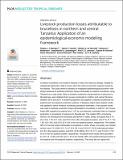| dc.contributor.author | Mendes, Ângelo | |
| dc.contributor.author | Haydon, Daniel | |
| dc.contributor.author | Glanville, William | |
| dc.contributor.author | Bodenham, Rebecca | |
| dc.contributor.author | Lukambagire, AbdulHamid | |
| dc.contributor.author | Johnson, Paul | |
| dc.contributor.author | Shirima, Gabriel | |
| dc.contributor.author | Cleaveland, Sarah | |
| dc.contributor.author | McIntosh, Emma | |
| dc.contributor.author | Hanley, Nick | |
| dc.contributor.author | Halliday, Jo | |
| dc.date.accessioned | 2025-04-04T10:45:35Z | |
| dc.date.available | 2025-04-04T10:45:35Z | |
| dc.date.issued | 2025-02-14 | |
| dc.identifier.uri | https://doi.org/10.1371/journal.pntd.0012814 | |
| dc.identifier.uri | https://dspace.nm-aist.ac.tz/handle/20.500.12479/2996 | |
| dc.description | This research article was published by Vaccine PLOS Negleted Tropical Diseases, 2025 | en_US |
| dc.description.abstract | Malignant catarrhal fever (MCF), caused by alcelaphine herpesvirus-1 (AIHV-1) transmitted from wildebeest, is a lethal cattle disease with significant impacts on East African pastoralists. Development of a live attenuated MCF vaccine has prompted research into its use in communities at risk. This study reports results from the first utilisation of the MCF vaccine in locally-owned cattle under field conditions. The study involved a primary two-dose course vaccination of 1634 cattle, followed a year later, by boost vaccination of 385 of these cattle. It aimed to: (a) evaluate the antibody response to a two-dose AlHV-1 primary vaccination course, including initial response, antibody levels after one year, and clinical events post-vaccination; (b) assess how factors like age, reproductive status, body condition, and breed influence the initial response; and (c) compare antibody responses to single- and two-dose booster protocols one year after primary vaccination. Analyses were carried out using linear mixed-effects models and paired t-tests.
Clinical incidents were reported in 11/1634 cattle vaccinated during the primary course and in 0/385 cattle during the boost regimens. The primary vaccination resulted in a 9-fold increase in comparison to pre-vaccination antibody levels and the response was consistent across animals of different ages, reproductive statuses and body conditions. While antibody levels declined 11 months after primary vaccination, they remained high, and a single-dose booster vaccination was sufficient to elicit a strong immune response, with only marginal increases after a second booster.
The study provides evidence of high immunogenicity and low incidences of clinical events of the vaccine in cattle across individual host factors and immunologically vulnerable groups, under prevailing environmental conditions. It also indicates the utility of a single-dose booster regimen. These findings will support progress towards commercial production and larger-scale adoption which could generate important benefits for the livelihoods, and sustainability of pastoral livestock systems. | en_US |
| dc.description.sponsorship | Livestock brucellosis is an endemic disease in many low-resource settings. Despite its widespread distribution, little is known about the scale of economic impacts caused by the disease. This study aimed to develop an integrated epidemiological-economic modelling framework to estimate production losses attributable to livestock brucellosis, using Tanzania as a case study. Data on livestock production and prevalence of exposure to Brucella spp. were obtained from surveys conducted in northern and central Tanzania between 2013 and 2019. A clustering algorithm was applied to classify households into pastoral and non-pastoral production systems. A Bayesian latent-class analysis model was applied to derive livestock brucellosis prevalence estimates. A herd-growth model was used to estimate production losses attributable to brucellosis. A total of 1,541 households (384 classified as pastoral and 1,157 as non-pastoral) contributed data on livestock production or prevalence of exposure to Brucella spp. The median (95% uncertainty interval, UI) individual-level brucellosis prevalence in cattle, sheep, and goats was 5.1% (3.4–6.9), 1.3% (0.1–3.0), and 2.5% (0.3–4.8) in the pastoral system, and 0.7% (0.1–1.6), 1.6% (0.2–3.8), and 2.5% (0.3–4.9) in the non-pastoral system, respectively. The median (95% UI) annual losses attributable to brucellosis in cattle, sheep, and goats, per infected animal, were 74.4 (26.2–211.7), 9.7 (3.4–23.1) and 10.6 (3.7–25.0) international dollars (int. $) in the pastoral system, and 62.3 (16.8–228.6), 6.3 (1.8–17.1) and 7.0 (2.2–17.9) int. $ in the non-pastoral system, respectively. Household-level losses were equivalent to 4.4% (2.1–8.8) and 0.6% (0.2–1.6) of the median (95% UI) livestock-derived income in the pastoral and non-pastoral systems, respectively. This study did not capture the system-wide impacts of brucellosis, including on human health. The estimated losses are only a part of the full societal economic impact of the disease. These results can be used to inform cost-benefit analyses of potential interventions and guide policy development for brucellosis control | en_US |
| dc.language.iso | en | en_US |
| dc.publisher | Public Library of Science | en_US |
| dc.subject | Research Subject Categories::NATURAL SCIENCES | en_US |
| dc.title | Livestock production losses attributable to brucellosis in northern and central Tanzania: Application of an epidemiological-economic modelling framework | en_US |
| dc.type | Article | en_US |

